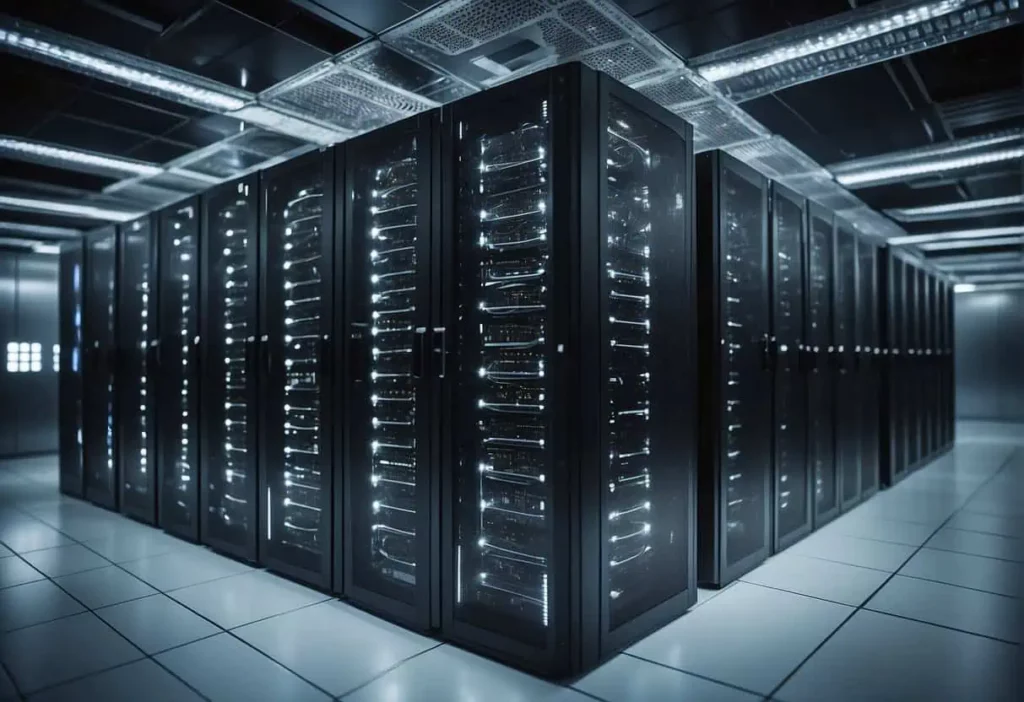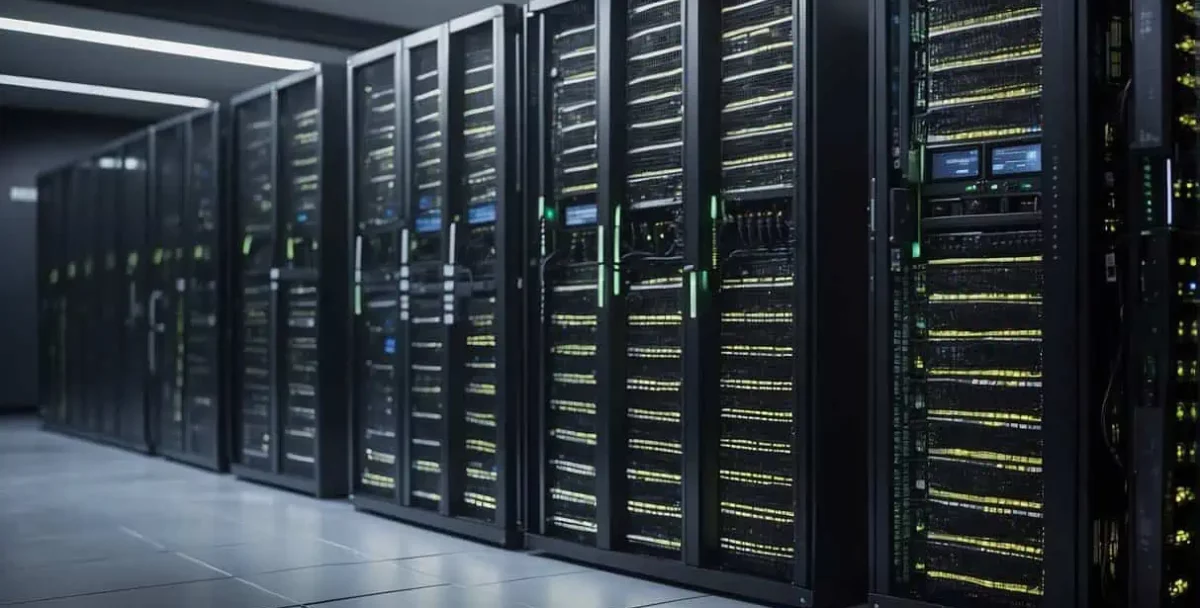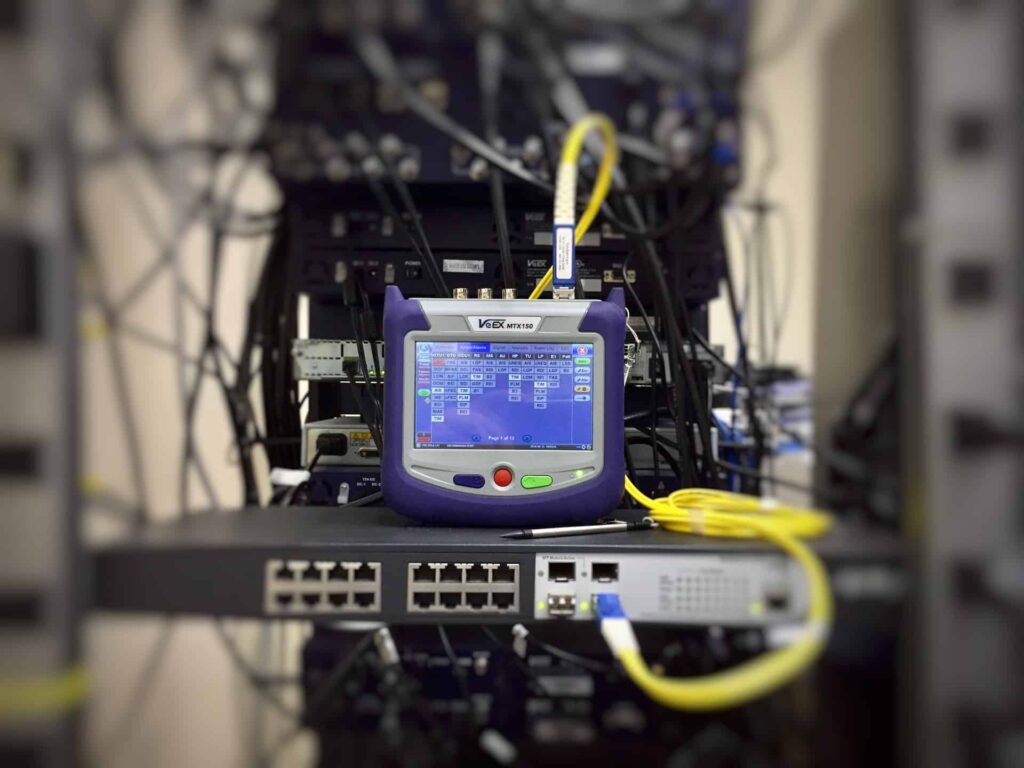Data center architecture is the structured layout designed to support a data center’s computing, storage, and networking resources. It specifies how a multitude of components like servers, storage systems, and networking devices are organized and interconnected within a facility. The architecture is critical as it determines the data center’s efficiency, flexibility, and scalability, ensuring it can accommodate current and future IT demands. The constant evolution of computing technologies, increasing demand for resources, and the need for reliable, secure data storage and management necessitate a well-thought-out data center design.
A key component in data center design is the physical infrastructure, which encompasses space planning, power distribution, cooling systems, and physical security mechanisms. These elements support the core hardware and software systems, enabling the execution of a variety of applications and services that enterprises rely on. On top of the foundational infrastructure, data center network architecture interconnects the array of devices and facilitates communication between data storage solutions and computing resources, thereby forming the backbone of the data center’s capability to process and manage large volumes of data.
Key Takeaways
- Effective data center architecture must integrate servers, storage, and networking to support applications and services.
- The design and infrastructure of a data center are crucial for ensuring scalability, efficiency, and security.
- Continuous management and adoption of new technologies are necessary for maintaining operability and supporting business continuity.
Design Principles and Standards

When architects design data centers, they must adhere to defined principles and standards to ensure operational efficiency and reliability. Standards set by entities like the Uptime Institute provide a framework for scalability, redundancy, fault tolerance, and energy efficiency.
The Uptime Institute’s Tier Classification System is a critical standard in data center design. The system ranges from Tier I to Tier IV, categorizing facilities based on redundancy and fault tolerance. A Tier I center has a single path for power and cooling and no redundant components, offering limited protection against operational interruptions. Higher tiers improve on these aspects, culminating in Tier IV, which offers full fault tolerance and 96 hours of power outage protection.
- Scalability: Data centers must be designed to accommodate growth without compromising existing operations.
- Redundancy: Essential to ensure that backup systems are in place, such as power supplies or cooling systems, to maintain operations during component failures.
- Fault Tolerance: The architecture must tolerate and isolate faults to prevent them from affecting the entire system.
- Energy Efficiency: Critical in reducing operational costs and environmental impact. Implementing energy-efficient systems and designs is paramount.
Designers incorporate these principles as follows:
- Tier Level | Scalability | Redundancy | Fault Tolerance | Energy Efficiency
- — | — | — | — | —
- Tier I | Limited | N/A | N/A | Standard
- Tier II | Moderate | Partial | N/A | Improved
- Tier III | High | N+1 | N+1 | High Efficiency
- Tier IV | Highest | 2N+1 | 2(N+1) | Highest Efficiency
In summary, companies must balance cost against the level of uptime required. While higher tiers offer greater protection and capability, they also demand a larger investment. Therefore, architects prioritize requirements to align the data center design with the organization’s objectives while complying with established standards for a robust and effective data environment.
Physical Infrastructure

The physical infrastructure of a data center underpins its functionality, providing a robust and secure environment for critical IT equipment such as servers and data storage devices.
Building and Space
A data center’s building must accommodate a variety of spatial needs. Construction of these facilities focuses on optimizing the space to support the scale of IT operations, which may include thousands of physical servers. Efficient use of space is critical, taking into consideration future growth and expansion potential.
Power Supply and Cooling Systems
Power is the lifeblood of a data center, with a redundant supply being crucial. Facilities typically employ a combination of uninterruptible power supplies (UPS) and backup generators to ensure a consistent power flow. Cooling systems, essential for dissipating heat, include ventilation and fans. Sophisticated cooling technologies ensure that equipment operates within safe temperature ranges, thus avoiding overheating.
Security and Safety
Data centers prioritize both security and safety of their physical premises. They employ robust firewalls and controlled access points to secure the data within. Additionally, facilities are equipped with fire suppression systems and protocols to ensure safety against physical threats. These security measures are designed to safeguard against both external and internal risks.
Core Data Center Network Architecture

In the realm of data center network architecture, the core component serves as the pivotal point of connectivity and functionality, facilitating efficient data flow and providing robust support for the demanding network infrastructure.
Modern Networking Layout
Data center network (DCN) architecture has evolved to meet the increasing demands for scalability and performance in contemporary IT environments. The network fabric within modern data centers is designed to provide a resilient and flexible framework for data traffic. Crucial to the fabric’s efficiency are core layer switches, which interconnect with aggregate layer switches and the access layer, forming a hierarchical structure to manage the flow of information efficiently.
Components and Topology
- Access Layer: At the foundation of the structure, one finds the access layer, typically composed of access layer switches. These switches connect directly to servers, handling incoming and outgoing server traffic.
- Aggregate Layer: Also known as the distribution layer, the aggregate layer acts as a mediator, granting an effective communication bridge between the access and core layers. Aggregate layer switches help to consolidate data flow from multiple access switches before it is routed to the core layer.
- Core Layer: The core layer, at the apex of the data center network topology, is designed to be highly redundant and efficient, equipped with core layer switches that possess robust processing capabilities. These switches are pivotal in interconnecting different segments of the network, ensuring a smooth and uninterrupted flow of data. The layer employs high-performance routers and utilizes a mesh of cables and switches to sustain the high volume of cross-network traffic.
In constructing a DCN, the quality and capability of physical components such as routers, switches, and cables are fundamental, as they dictate the network’s overall performance and reliability. The choices made in network design and component selection are central to establishing a core architecture that meets present and future demands.
Data Storage Solutions
When designing a data center, choosing the right data storage solution is critical. Data storage in modern data centers has evolved to accommodate diversified needs, such as big data analysis, high-velocity file sharing, and robust storage systems that ensure data availability and integrity.
Cloud Storage and Object Stores: Solutions like Azure Blob Storage offer massively scalable object storage for text and binary data. This aligns well with big data storage requirements due to its scalability and the ability to handle large volumes of unstructured data.
On-Premises Storage: Many organizations opt for on-premises storage architectures to maintain control over their sensitive data. The key to effective on-premises storage lies in the right mix of hardware and virtualization, ensuring optimal usage of compute, storage, and networking resources.
Hybrid Arrays: Hybrid storage arrays combine both flash and hard disk drives to balance cost with performance, allowing for faster access where needed and cost-effective storage for less critical data.
- File Sharing Systems: Companies often deploy file sharing protocols within their storage solutions to facilitate collaboration and ease of data access. This allows for sharing large files within the data center network securely and efficiently.
Software-Defined Infrastructure (SDI): This approach abstracts the storage resources, pooling them to serve users more effectively. Through virtualization, resources can be allocated dynamically, leading to improved efficiency and reduced unused capacity.
In considering which data storage technology to adopt, factors such as data size, access speed, and application priority dictate the choice. It is imperative for a data center to align its storage technology with its overall goals and the specific demands of the data it holds.
Computing Resources
Data centers house the critical computing resources that support a vast array of applications and workloads. These resources are meticulously managed and often deployed across various environments, including on-premises, public cloud, and at the edge, to ensure efficient and resilient operations.
Server Management
Modern data centers deploy a multitude of servers, each designed to handle specific tasks and applications. Effective server management is paramount, involving the organization, alignment of resources, and ensuring that servers operate at optimal performance levels. In practice, this often includes:
- Monitoring system health and performance.
- Maintaining software updates and security patches.
- Allocating computing resources like CPU, memory, and storage to balance loads and maximize efficiency.
On-premises servers are managed directly within the facility, while multicloud and edge computing extend this management to include remote and distributed resources.
Virtualization and Cloud Solutions
Virtualization plays a critical role in data center architecture, abstracting hardware and creating multiple simulated environments or dedicated resources from a single physical setup. This technique enhances utilization rates and allows for:
- Efficient resource distribution through virtual machines (VMs).
- Rapid scalability to meet fluctuating demand.
- Isolation of workloads for increased security.
Cloud Computing has emerged as a transformative force, offering public cloud services that scale on demand and bring forth economic benefits. Data centers often employ a multicloud strategy to leverage the best services from different cloud providers, while cloud solutions like Containerization cater to the needs of modern applications, promoting agility and continuity.
By incorporating these sophisticated computing strategies, data centers deliver robust and versatile platforms for the ever-evolving landscape of digital services and requirements.
Network Services and Applications
The architecture of data centers incorporates an array of network services and applications to ensure efficient data throughput and low latency, vital for a spectrum of uses ranging from social media to machine learning.
Access and Distribution
In any data center, network access is the gateway through which users and devices connect to various applications. It optimizes user experience by enabling seamless entry to the network’s resources. The distribution layer acts as an intermediary, streamlining data flow between access and core layers, improving application performance and enhancing security measures.
- Access Layer Features:
- Provides connectivity for devices and end-users
- Implements policies for network access control
- Distribution Layer Functions:
- Aggregates data from access switches
- Routes and filters packets, balancing loads
Application Performance Management
Application Performance Management (APM) is a suite of analytics and management tools that monitor the performance of applications housed within a data center. They focus on two main aspects: throughput and latency which are crucial for maintaining an efficient operational environment.
- Throughput Maximization:
- Ensures data is transferred at high speeds
- Sustains the demands of high-volume applications like social media and email
- Latency Reduction:
- Decreases the delay in data transmission
- Critical for real-time applications, AI, and machine learning algorithms
APM tools not only provide visibility into the performance of applications but also help mitigate issues, ensuring consistent and reliable application delivery. By leveraging these tools, data centers can enhance user experience and the performance of advanced applications.
Operational Management
Operational management in data center architecture is crucial for businesses seeking reliability and high availability of services. It encompasses the organization and oversight of infrastructure, ensuring that systems run smoothly and meet specified service level agreements (SLAs).
Automation has emerged as a pivotal element within modern data centers to tackle complex processes that surpass human capabilities. It streamlines workflows, enables rapid scalability, and assists with real-time troubleshooting, significantly improving efficiency and reducing the potential for human error.
Effective operational management also involves continuous monitoring of both physical and virtual infrastructure elements. This real-time observation is integral to maintaining the operational integrity of the data center and providing insight for proactive maintenance and dynamic management responses.
| Key Component | Description |
|---|---|
| Management | Involves strategic planning, resource allocation, and administering policies. |
| Organization | Ensures optimal structuring of teams and technologies for maximum efficiency. |
| Service Level Agreements (SLAs) | Formalized agreements that help guarantee uptime, performance, and response times. |
| Troubleshooting | Identifies, diagnoses, and resolves issues swiftly to minimize the impact on services. |
Operational management serves as the backbone of business stability, with a direct impact on the availability of services. As data centers become larger and more complex, the approaches to managing such environments must also evolve with the same precision and efficiency.
Disaster Recovery and Business Continuity
In the context of data center architecture, disaster recovery (DR) and business continuity (BC) are crucial strategies to ensure operational resilience and regulatory compliance. Disaster recovery involves restoring IT and data center operations following a disruptive event. It outlines the processes to recover lost data and resume applications.
Resiliency plays a significant role in DR, referring to the data center’s ability to adapt and respond to risks, from natural disasters to cyber-attacks. Resilient data center architectures integrate redundancy and fault tolerance to mitigate potential disruptions.
Backup generators are a common physical safeguard in data centers. They provide an alternate power supply to maintain critical functions in the event of a power outage. The integration of these generators is a physical manifestation of business continuity principles.
Here are essential components in disaster recovery and business continuity planning:
- Objective Formulation:
- Defining Recovery Time Objectives (RTO)
- Establishing Recovery Point Objectives (RPO)
- Technology Tools:
- Utilizing replication technologies like Hitachi TrueCopy and Hitachi Universal Replicator
- Architecture Types:
- Active-Active
- Active-Passive
- Hybrid constructs that balance cost with resilience
Business continuity covers the entirety of operations and aims to maintain business functions during and after a disaster. It goes beyond data recovery, focusing on the continuous operation of the entire organization.
Key Differences:
- DR is reactive, dealing primarily with data and system recovery.
- BC is proactive, encompassing a broader scope of sustained operations.
The synergy between disaster recovery and business continuity planning ensures that data centers can withstand and quickly recover from disruptions, thus maintaining uninterrupted business operations.
Frequently Asked Questions
Data center architecture is critical for successful IT operations, involving intricate design and detailed responsibilities. These FAQs address the core aspects, roles, designs, types, construction processes, and design standards central to the field.
What are the primary components involved in data center infrastructure?
The primary components of data center infrastructure typically include servers, storage systems, networking devices, power supplies, cooling systems, and physical racks. These elements work in unison to support the processing, storage, and dissemination of data.
What roles and responsibilities define a data center architect?
A data center architect is responsible for designing the layout and systems of a data center. They must ensure that the infrastructure is scalable, reliable, and efficient while meeting the data and computing requirements of the organization.
How is modern data center architecture typically designed?
Modern data center architecture is often designed with virtualization and modularity in mind to improve scalability and utilization. Emphasis is placed on energy efficiency, reducing the facility’s carbon footprint, and accommodating future technology integrations.
What are the key types of data center architectures currently in use?
Currently, data center architectures include traditional on-premises centers, colocation facilities, cloud data centers, edge computing centers, and centers utilizing modular or containerized designs. Each serves different needs and scales according to demand.
Can you describe the standard process for constructing a data center?
Constructing a data center commonly starts with thorough planning of the layout and infrastructure, followed by site selection, calculating power and cooling requirements, and ensuring compliance with industry standards. The actual construction phase carefully adheres to the predefined architectural design and planning.
What are the generally accepted design standards for data centers?
Design standards for data centers are guided by industry best practices and certifications such as those from Uptime Institute’s Tier Standard and ANSI/TIA-942. These standards dictate the specifications for redundancy, fault tolerance, and overall reliability.
Last Updated on February 12, 2024 by Josh Mahan


![Best data center racks Best data center racks [buyer’s guide]](https://cc-techgroup.com/wp-content/uploads/2021/08/best-data-center-racks-1024x576.jpg)

